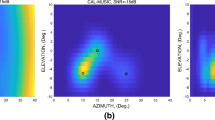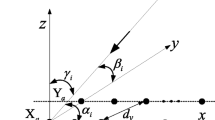Abstract
In this paper, we develop a robust direction-of-arrival (DOA) estimation algorithm with a nested array with unknown mutual coupling. By using the matrix transformation of the product of mutual coupling matrix and steering vector, we firstly derive a coarray signal model including a manifold matrix without mutual coupling effect. Subsequently, we build the block sparse representation of the coarray signal by exploiting the sparsity of the signals. Finally, we estimate the DOAs of sources by formulating a simplified block sparse recovery problem. The proposed algorithm utilizes all coarray outputs and reduces the influence of mutual coupling effect, and thus can resolve more sources than the number of sensors. Numerical results demonstrate the superiority of the proposed algorithm over several existing techniques.




Similar content being viewed by others
Data Availability Statement
My manuscript has no associated data.
References
E. BouDaher, F. Ahmad, M.G. Amin, A. Hoorfar, Mutual coupling effect and compensation in non-uniform arrays for direction-of-arrival estimation. Digital Signal Process. 61, 3–14 (2017)
S. Cai, A normalized spatial spectrum for DOA estimation with uniform linear arrays in the presence of unknown mutual coupling, in Proc. IEEE Int. Conf. Acoust., Speech Signal Process. (ICASSP), Shanghai, China, pp. 3086–3090 (2016)
F. Chen, J. Dai, N. Hu, Z. Ye, Sparse Bayesian learning for off-grid DOA estimation with nested arrays. Digital Signal Process. 82, 187–193 (2018)
J. Dai, X. Bao, N. Hu, C. Chang, W. Xu, A recursive RARE algorithm for DOA estimation with unknown mutual coupling. IEEE Antennas Wireless Propag. Lett. 13, 1593–1596 (2014)
J. Dai, D. Zhao, X. Ji, A sparse representation method for DOA estimation with unknown mutual coupling. IEEE Antennas Wireless Propag. Lett. 11, 1210–1213 (2012)
B. Friedlander, A.J. Weiss, Direction finding in the presence of mutual coupling. IEEE Trans. Antennas Propag. 39(3), 273–284 (1991)
H. Krim, M. Viberg, Two decades of array signal processing research: the parametric approach. IEEE Signal Process. Mag. 13(4), 67–94 (1996)
J. Li, Y. He, P. Ma, X. Zhang, Q. Wu, Direction of arrival estimation using sparse nested arrays with coprime displacement. IEEE Sens. J. 21(4), 5282–5291 (2021)
Z. Li, X. Zhang, P. Gong, C. Wang, Sparse nested linear array for direction of arrival estimation. Signal Process. 169, 107372 (2020)
M. Lin, L. Yang, Blind calibration and DOA estimation with uniform circular arrays in the presence of mutual coupling. IEEE Antennas Wireless Propag. Lett. 5, 315–318 (2006)
Z. Liu, Z. Huang, F. Wang, Y. Zhou, DOA estimation with uniform linear arrays in the presence of mutual coupling via blind calibration. Signal Process. 89(7), 1446–1456 (2009)
C.L. Liu, P.P. Vaidyanathan, Super nested arrays: linear sparse arrays with reduced mutual coupling-part I: fundamentals. IEEE Trans. Signal Process. 64(15), 3997–4012 (2016)
C.L. Liu, P.P. Vaidyanathan, Remarks on the spatial smoothing step in coarray MUSIC. IEEE Signal Process. Lett. 22(9), 1438–1442 (2015)
H. Liu, L. Zhao, Y. Li, X. Jing, T. Truong, A sparse-based approach for DOA estimation and array calibration in uniform linear array. IEEE Sens. J. 16(15), 6018–6027 (2016)
Z. Liu, Y. Zhou, A unified framework and sparse Bayesian perspective for direction-of-arrival estimation in the presence of array imperfections. IEEE Trans. Signal Process. 61(15), 3786–3798 (2013)
P. Pal, P.P. Vaidyanathan, On application of LASSO for sparse support recovery with imperfect correlation awareness, in Proc. 46th Asilomar Conf. Signals, Syst., Comput. (ASILOMAR), Pacific Grove, CA, USA (2012), p. 958–962
P. Pal, P.P. Vaidyanathan, Nested arrays: a novel approach to array processing with enhanced degrees of freedom. IEEE Trans. Signal Process. 58(8), 4167–4181 (2010)
G. Qin, Y.D. Zhang, M.G. Amin, DOA estimation exploiting moving dilated nested arrays. IEEE Signal Process. Lett. 26(3), 490–494 (2019)
F. Sellone, A. Serra, A novel online mutual coupling compensation algorithm for uniform and linear arrays. IEEE Trans. Signal Process. 55(2), 560–573 (2007)
J. Shen, J. Li, B. Zhu, C. Ye, A blind direction of arrival and mutual coupling estimation scheme for nested array, in Proc. IEEE Sensor Array and Multichannel Signal Processing Workshop (SAM), Hangzhou, China (2020), p. 1–5
X. Su, P. Hu, Z. Liu, J. Shi, X. Li, Deep alternating projection networks for gridless DOA estimation with nested array. IEEE Signal Process. Lett. 29, 1589–1593 (2022)
Q. Wang, T. Dou, H. Chen, W. Yan, W. Liu, Effective block sparse representation algorithm for DOA estimation with unknown mutual coupling. IEEE Commun. Lett. 21(12), 2622–2625 (2017)
Y. Wang, A. Hashemi-Sakhtsari, M. Trinkle, B.W.-H. Ng, Sparsity-aware DOA estimation of quasi-stationary signals using nested arrays. Signal Process. 144, 87–98 (2018)
M. Wang, X. Ma, S. Yan, C. Hao, An autocalibration algorithm for uniform circular array with unknown mutual coupling. IEEE Antennas Wirel. Propag. Lett. 15, 12–15 (2016)
X. Wang, D. Meng, M. Huang, L. Wan, Reweighted regularized sparse recovery for DOA estimation with unknown mutual coupling. IEEE Commun. Lett. 23(2), 290–293 (2019)
A.J. Weiss, B. Friedlander, Effects of modeling errors on the resolution threshold of the MUSIC algorithm. IEEE Trans. Signal Process. 42(6), 1519–1526 (1994)
C. Wen, G. Shi, X. Xie, Estimation of directions of arrival of multiple distributed sources for nested array. Signal Process. 130, 315–322 (2017)
J. Yang, G. Liao, J. Li, An efficient off-grid DOA estimation approach for nested array signal processing by using sparse Bayesian learning strategies. Signal Process. 128, 110–122 (2016)
Z. Ye, J. Dai, X. Xu, X. Wu, DOA estimation for uniform linear array with mutual coupling. IEEE Trans. Aerosp. Electron. Syst. 45(1), 280–288 (2009)
Z. Ye, C. Liu, On the resiliency of MUSIC direction finding against antenna sensor coupling. IEEE Trans. Antennas Propag. 56(2), 371–380 (2008)
X. Zhang, T. Jiang, Y. Li, Y. Zakharov, A novel block sparse reconstruction method for DOA estimation with unknown mutual coupling. IEEE Commun. Lett. 23(10), 1845–1848 (2019)
Z. Zheng, Y. Huang, W.-Q. Wang, H.C. So, Augmented covariance matrix reconstruction for DOA estimation using difference coarray. IEEE Trans. Signal Process. 69, 5345–5358 (2021)
Z. Zheng, W. Wang, Y. Kong, Y.D. Zhang, MISC array: a new sparse array design achieving increased degrees of freedom and reduced mutual coupling effect. IEEE Trans. Signal Process. 67(7), 1728–1741 (2019)
Z. Zheng, C. Yang, W.-Q. Wang, H.C. So, Robust DOA estimation against mutual coupling with nested array. IEEE Signal Process. Lett. 27, 1360–1364 (2020)
Acknowledgements
This work was supported in part by the National Natural Science Foundation of China under Grant 62171089, by the Natural Science Foundation of Sichuan Province under Grant 2022NSFSC0497, by the Sichuan Science and Technology Program under Grant 2022YFG0162, by the Guangdong Basic and Applied Basic Research Foundation under Grant 2023A1515011163, and by the Shenzhen Science and Technology Program under Grant JCYJ20210324143004012.
Author information
Authors and Affiliations
Corresponding author
Ethics declarations
Conflict of interest
The authors declare that they have no known competing financial interests or personal relationships that could have appeared to influence the work reported in this paper.
Additional information
Publisher's Note
Springer Nature remains neutral with regard to jurisdictional claims in published maps and institutional affiliations.
Rights and permissions
Springer Nature or its licensor (e.g. a society or other partner) holds exclusive rights to this article under a publishing agreement with the author(s) or other rightsholder(s); author self-archiving of the accepted manuscript version of this article is solely governed by the terms of such publishing agreement and applicable law.
About this article
Cite this article
Xu, Y., Zheng, Z. & Wang, WQ. Block Sparse Recovery Approach for DOA Estimation in Nested Array with Unknown Mutual Coupling. Circuits Syst Signal Process 42, 5079–5090 (2023). https://doi.org/10.1007/s00034-023-02351-0
Received:
Revised:
Accepted:
Published:
Issue Date:
DOI: https://doi.org/10.1007/s00034-023-02351-0




